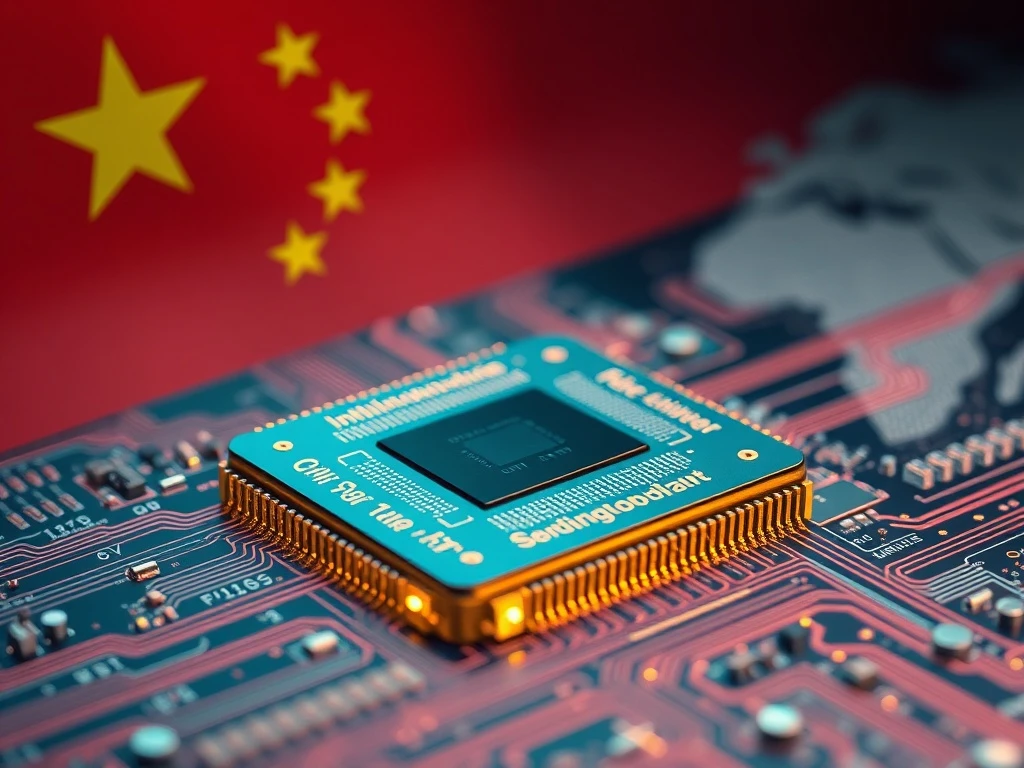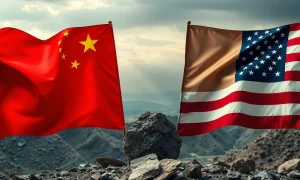The global technology landscape is constantly shifting. Geopolitical tensions frequently impact major players. Recently, the United States has tightened its export controls. This move creates significant new hurdles for tech giants. For instance, **Nvidia**, a leading chipmaker, now faces renewed challenges in a crucial market: China. This situation demands a closer look. It affects not only Nvidia’s operations but also the broader semiconductor industry. Understanding these dynamics is essential for investors and industry observers alike.
Nvidia Confronts Escalating China Export Controls
The U.S. government recently announced updated restrictions. These rules target advanced semiconductor exports to China. Previously, these controls aimed at preventing China’s military modernization. Now, however, the scope has expanded. This directly impacts high-performance chips. Such components are vital for artificial intelligence (AI) and high-performance computing (HPC). **Nvidia’s** cutting-edge graphics processing units (GPUs) fall squarely within these categories. Therefore, these regulations pose a direct threat to the company’s significant revenue streams from the Chinese market.
Specifically, the new regulations restrict the sale of chips that exceed certain performance thresholds. These thresholds are defined by factors like processing power and inter-chip bandwidth. Companies must obtain a license for exports that surpass these limits. This process is often difficult. Consequently, it creates uncertainty for exporters. **Nvidia** had previously developed specific chips, like the A800 and H800. These versions were ‘de-tuned’ to comply with earlier U.S. export rules. Yet, the latest updates appear to target even these modified products. This makes compliance increasingly complex for **Nvidia** and its partners.
Furthermore, the U.S. Commerce Department’s Bureau of Industry and Security (BIS) enforces these rules. They aim to prevent China from acquiring advanced technologies. These technologies could enhance its military capabilities. The restrictions also seek to limit China’s ability to develop its own advanced AI systems. This strategic competition directly impacts commercial trade. Thus, **Nvidia** must constantly adapt its product offerings and sales strategies. They must navigate this intricate regulatory environment.
The Broader Impact on Nvidia’s Revenue and Strategy
China represents a substantial market for **Nvidia**. It contributes significantly to its data center and gaming revenue. The data center segment, in particular, relies heavily on sales of AI chips. These chips power cloud computing, large language models, and scientific research. Losing access to this market, or facing severe limitations, could impact **Nvidia’s** financial performance. Analysts are closely watching for any official statements. They want to understand the full extent of the potential revenue hit.
For example, in fiscal year 2023, China accounted for a notable portion of **Nvidia’s** overall sales. The company’s data center revenue surged. This growth was partly driven by demand from Chinese cloud providers and tech firms. Therefore, any disruption here is significant. It could slow the company’s impressive growth trajectory. Moreover, it forces **Nvidia** to re-evaluate its long-term market strategy. The company needs to find alternative growth drivers. It also needs to mitigate risks associated with geopolitical tensions.
To counteract these challenges, **Nvidia** is exploring several strategic adaptations. These include:
- Developing Compliant Products: They may design even lower-performance chips for the Chinese market. These chips would strictly adhere to the new export thresholds.
- Diversifying Geographically: **Nvidia** is increasing its focus on other fast-growing markets. This includes regions like Europe, Japan, and the Middle East.
- Strengthening Software Ecosystem: The company continues to invest in its software platforms. This includes CUDA and Omniverse. These platforms create stickiness with customers. They also add value beyond hardware sales.
Ultimately, **Nvidia’s** ability to adapt will determine its resilience. The company must balance compliance with maintaining market share. This is a delicate act in a volatile global economy.
China’s Domestic Ambitions and Competition for Nvidia
Beyond U.S. export controls, **Nvidia** faces another significant challenge: China’s push for self-sufficiency. Beijing has made chip independence a national priority. This ambition drives massive investments in domestic semiconductor companies. Chinese firms are rapidly developing their own AI chips and GPUs. They aim to reduce reliance on foreign technology. This trend creates a dual threat for **Nvidia**. It not only restricts market access but also fosters local competition.
Companies like Huawei and Biren Technology are notable examples. Huawei’s Ascend series of AI processors is gaining traction. Biren Technology is also developing powerful GPUs. These firms are receiving substantial government support. They benefit from preferential policies and funding. Consequently, they are becoming viable alternatives for Chinese customers. This domestic competition means that even if export controls ease, **Nvidia** may still face a shrinking market share. Chinese customers may simply choose local suppliers. This supports national strategic goals.
The rise of domestic alternatives complicates **Nvidia’s** strategy. They must compete on performance, price, and ecosystem. However, local companies often have an inherent advantage. They can work more closely with Chinese clients. They can also customize solutions more readily. This makes it harder for **Nvidia** to maintain its dominant position. Therefore, the company needs to innovate constantly. It must offer unparalleled value to retain its global leadership. This includes both hardware and software solutions.
Navigating Geopolitical Tensions: Nvidia’s Strategic Adaptations
Operating in the current geopolitical climate requires significant strategic agility. **Nvidia** is actively engaging with governments and industry bodies. They aim to shape policies and ensure a level playing field. Lobbying efforts focus on promoting open trade and technological collaboration. However, national security concerns often override commercial interests. This makes the situation particularly challenging for **Nvidia**.
The company is also exploring new business models. For instance, they might shift towards more licensing agreements. They could also focus on providing AI infrastructure as a service. These models could potentially circumvent some hardware-specific restrictions. Furthermore, **Nvidia** is strengthening its research and development. They are investing heavily in next-generation technologies. This ensures they remain at the forefront of innovation. Their goal is to maintain a technological lead. This lead makes their products indispensable, even with restrictions.
Moreover, **Nvidia** is cultivating stronger relationships with global partners. This includes cloud service providers, enterprise customers, and academic institutions. These partnerships help diversify its customer base. They also provide new avenues for growth. The company recognizes the long-term nature of these geopolitical shifts. Thus, its strategy is not merely reactive. It is proactive and forward-looking. They are building a resilient business model. This model can withstand future disruptions. Ultimately, **Nvidia** aims to solidify its position as a leader in AI and accelerated computing. They strive to do this despite external pressures.
The Road Ahead for Nvidia in a Fragmented World
The challenges for **Nvidia** in China are multifaceted. They stem from both U.S. export controls and China’s domestic ambitions. These factors create a complex operating environment. **Nvidia** must balance global market access with regulatory compliance. They must also manage intense competition. This situation highlights the increasing fragmentation of the global technology market. Nations are prioritizing self-reliance. This trend impacts global supply chains and trade flows. It also affects technological development.
Despite these hurdles, **Nvidia** possesses significant strengths. Its technological leadership is undeniable. Its ecosystem of developers and researchers is robust. The global demand for AI and accelerated computing remains high. Therefore, while China presents a hurdle, it is not an insurmountable one. **Nvidia’s** ability to innovate, adapt, and diversify will be key. The company’s future success hinges on its strategic foresight. It also depends on its operational flexibility. They must continue to deliver cutting-edge solutions. This will ensure their continued dominance in a rapidly evolving world.
Frequently Asked Questions (FAQs)
What new hurdles does Nvidia face in China?
Nvidia faces new U.S. government export controls on advanced AI chips to China. These rules restrict the sale of high-performance GPUs. They also make it harder for Nvidia to sell even its ‘de-tuned’ chips, like the A800 and H800, without special licenses.
How do these restrictions impact Nvidia’s revenue?
China is a significant market for Nvidia, particularly in its data center segment. The restrictions could limit sales of high-margin AI chips. This may potentially slow the company’s revenue growth. Analysts are closely monitoring the full financial impact.
Is China developing its own alternatives to Nvidia’s chips?
Yes, China is heavily investing in domestic semiconductor companies. Firms like Huawei and Biren Technology are developing their own AI chips and GPUs. They aim to reduce reliance on foreign technology. This creates significant local competition for Nvidia.
How is Nvidia adapting to these challenges?
Nvidia is adapting by developing compliant products with lower performance. They are also diversifying geographically into other markets. Furthermore, they are strengthening their software ecosystem. They also engage with governments to shape policies.
What is the long-term outlook for Nvidia in the Chinese market?
The long-term outlook is complex. Nvidia faces ongoing geopolitical tensions and rising domestic competition. However, the company’s technological leadership and strong ecosystem provide resilience. Its future success depends on continued innovation and strategic adaptation to these evolving market conditions.








